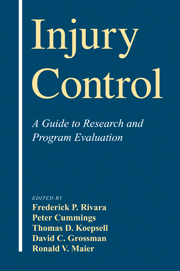Book contents
- Frontmatter
- Contents
- List of Contributors
- 1 An Overview of Injury Research
- 2 Classifying and Counting Injury
- 3 Measurement of Injury Severity and Co-morbidity
- 4 Data Linkages and Using Administrative and Secondary Databases
- 5 Rates, Rate Denominators, and Rate Comparisons
- 6 Data Collection Methods
- 7 Selecting a Study Design for Injury Research
- 8 Qualitative Methods in Injury Research
- 9 Randomized Trials
- 10 Cohort Studies in Injury Research
- 11 Case–Control Studies in Injury Research
- 12 Ecologic Studies
- 13 Case Series and Trauma Registries
- 14 Systematic Reviews of Injury Studies
- 15 Evaluating an Injury Intervention or Program
- 16 The Development of Clinical Decision Rules for Injury Care
- 17 Trauma Performance Improvement
- 18 Measuring Disability and Quality of Life Postinjury
- 19 Economic Evaluation of Injury Control
- 20 Ethical Issues
- Index
16 - The Development of Clinical Decision Rules for Injury Care
Published online by Cambridge University Press: 16 October 2009
- Frontmatter
- Contents
- List of Contributors
- 1 An Overview of Injury Research
- 2 Classifying and Counting Injury
- 3 Measurement of Injury Severity and Co-morbidity
- 4 Data Linkages and Using Administrative and Secondary Databases
- 5 Rates, Rate Denominators, and Rate Comparisons
- 6 Data Collection Methods
- 7 Selecting a Study Design for Injury Research
- 8 Qualitative Methods in Injury Research
- 9 Randomized Trials
- 10 Cohort Studies in Injury Research
- 11 Case–Control Studies in Injury Research
- 12 Ecologic Studies
- 13 Case Series and Trauma Registries
- 14 Systematic Reviews of Injury Studies
- 15 Evaluating an Injury Intervention or Program
- 16 The Development of Clinical Decision Rules for Injury Care
- 17 Trauma Performance Improvement
- 18 Measuring Disability and Quality of Life Postinjury
- 19 Economic Evaluation of Injury Control
- 20 Ethical Issues
- Index
Summary
Introduction
Reports of clinical decision rules are becoming increasingly common throughout the medical literature. Clinical decision rules (prediction rules) are designed to help physicians with diagnostic and therapeutic decisions at the bedside. We define a clinical decision rule as a decision-making tool, which is derived from original research (as opposed to a consensus-based clinical practice guideline) and incorporates three or more variables from the history, physical examination, or simple tests (Laupacis et al., 1997). These tools help clinicians cope with the uncertainty of medical decision making, predict prognosis, and improve efficiency in using resources, an important issue as health-care systems demand more cost-effective medical practice. A recently published example of a decision rule that helps emergency physicians cope with uncertainty is a guideline about which patients with community acquired pneumonia require hospitalization (Fine et al., 1997). A decision rule that predicts prognosis, would be a recent study to predict outcome in children after near drowning (Graf etal., 1995). Atypical example of a decision rule to improve resource use efficiency are the Ottawa Ankle Rules for the use of radiography in acute ankle injuries (Stiell et al., 1992a, 1993, 1994, 1995a; McDonald, 1994; Wasson and Sox, 1996).
Methodologic standards for the development of clinical decision rules have been described, originally by Wasson and Feinstein and more recently by our own research group (Wasson et al., 1985; Feinstein, 1987; Laupacis et al., 1997; Stiell and Wells, 1999). We consider the following to be the six important stages in the development and testing of a fully mature decision rule (Table 16.1).
Keywords
- Type
- Chapter
- Information
- Injury ControlA Guide to Research and Program Evaluation, pp. 217 - 235Publisher: Cambridge University PressPrint publication year: 2000



